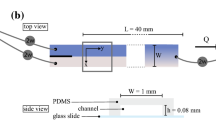Summary
-
1.
In bio-rheological experiments with starch sheaths and mitochondries in explantatesin vitro it is pointed out that it is possible by means ofStokes' law to measure the viscosity of protoplasm subjected to centrifugation;
-
2.
In these experiments the viscosity is increasing only till a critical value of the rotation velocity or shear rate, and in dependence on the measure of velocity it seems to approach a certain saturation value or even to decrease;
-
3.
Such a behaviour is explained as ofdilatant fluids or better, because an increase of volume is not demonstrable in the systems, asshear-rate blockage. The phenomenon finds a remarkable parallel case in birefringence and stain dichroism of the same objects;
-
4.
In practice, many difficulties have still to be overcome before an exploration on the flowing behaviour of centrifuged protoplasm can be obtained, but the results are not in opposition to former arguments of its Non-Newtonian nature.
Zusammenfassung
-
1.
In bio-rheologischen Versuchen mit Stärkescheiden und mit Mitochondrien in Explantaten in vitro ist es möglich, mittels desStokesschen Gesetzes die Viskosität des dem Zentrifugieren unterworfenen Protoplasma zu ermitteln.
-
2.
In diesen Versuchen wächst die Viskosität nur bis zu einem kritischen Werte der Umlaufgeschwindigkeit oder der „shear-rate“ und scheint es zu einem vom Geschwindigkeitsmaß abhängigen Sättigungswerte der Viskosität zu kommen.
-
3.
Solch ein Verhalten wird mit dem dilatanter Flüssigkeiten oder — weil eine Volumzunahme nicht nachweisbar ist — mit einer shear-rate blockage gedeutet. Das Phänomen findet bemerkenswerte Parallelen in Veränderungen der Intensität der Doppelbrechung und des Färbungsdichroismus der zentrifugierten Objekte.
-
4.
So viele Schwierigkeiten auch zur Deutung des Fließverhaltens zentrifugierten Protoplasmas noch zu überwinden sein werden, so stehen doch die bisherigen Ergebnisse nicht in Widerstreit zu früheren Argumenten der Nicht-Newtonschen Natur des Protoplasmas.
Similar content being viewed by others
Schrifttum
Anderson, N. G., Techniques for the mass isolation of cellular components. In:G. Oster andA. W. Pollister, Physical Techniques in Biological Research3, 299 (New York 1956).
Burgers, J. M., andG. W. Scott Blair, Report on the principles of rheological nomenclature (Amsterdam 1949).
First international colloquium on Rheological Problems in Biology, Lund 1950. Abstracts and discussions. In:A. Frey-Wyssling, Deformation and flow in biological systems, p. 481 (Amsterdam 1952).
Heilbrunn, L. V., J. exper. Zool.43, 313 (1926)
Heilbrunn, L. V., The dynamics of living protoplasm, p. 25 (New York 1956)
Heilbrunn, L. V., The viscosity of protoplasm, p. 23 (Wien 1958).
Larson, E., Dissert. Philadelphia (Pa.), cit. beiHeilbrunn (4b, c).
Mayer, H., Physik dünner Schichten, Bd. 1 (Stuttgart 1950).
Meskat, W., Viskosimetrie. In:J. Hengstenberg, B. Sturm undO. Winkler, Messen und Regeln in der chemischen Technik, p. 698, 751 (Berlin-Göttingen-Heidelberg 1957).
Pfeiffer, H. H., Physics7, 302 (1936); s. auch: Fujii Jubil. Vol., 701 (Tokyo 1937), sowie Proceed. 7th Intern. Bot. Congr. Stockholm 1950, p. 361 (Stockholm 1953).
Pfeiffer, H. H., Das Polarisationsmikroskop als Meßinstrument in Biologie und Medizin, p. 55, 64 (Braunschweig 1949).
Pfeiffer, H. H., Discussion communication at connective tissue conference of the Eli Lilly Co. (Indianapolis, Ind. 1950).
Pfeiffer, H. H., Discussion remark at Symposium “Sulla struttura submicroscopica del protoplasma“, Naples 1950. Pubbl. Staz. Zool. Napoli23, Suppl., 181 (1951).
Rheo-Dichroism. In:Frey-Wyssling, l. c. 488 (1952).
Pfeiffer, H. H., Proceed. 2nd Intern. Congr. Rheology Oxford, 373 (London 1954).
Pfeiffer, H. H., Symposion on fine structure of cells (Intern. Union of biolog. sciences publications, Ser. B, Nr. 21), p. 77 (Groningen 1955).
Pryce-Jones, J., Discussion on nomenclature at the Internat. Rheolog. Congr. Scheveningen, Sept. 1948.
Ruch, Fr., Birefringence and dichroism of cells and tissues. In:Oster andPollister, l. c. 149 (1956).
Seifriz, W., inFrey-Wyssling, l. c. 1 (1952).
Swann, M. M., andJ. M. Mitchison, J. exper. Biol.27, 226 (1950).
Author information
Authors and Affiliations
Rights and permissions
About this article
Cite this article
Pfeiffer, H.H. Versuche zu einem „shear-rate blockage“ Effekt am Protoplasma zentrifugierter Gewebe. Rheol Acta 1, 102–106 (1958). https://doi.org/10.1007/BF01968846
Received:
Issue Date:
DOI: https://doi.org/10.1007/BF01968846




